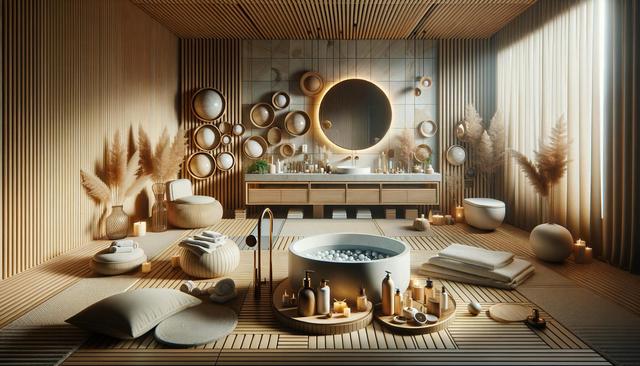Smart Technology for Everyday Wellness
Technology continues to reshape bathroom design in 2025, with smart features enhancing comfort, hygiene, and energy efficiency. From voice-activated lighting to water-saving digital faucets, the integration of intelligent systems supports a more sustainable lifestyle while also offering convenience. Smart mirrors with built-in health monitoring and LED lighting adjustments allow users to track wellness goals while preparing for the day. Additionally, app-connected showers and bathtubs let users pre-set water temperature and flow preferences, optimizing both relaxation and water management.
Among the most notable innovations are:
- Sensor-based lighting systems that adjust according to natural daylight and occupancy.
- Toilets with self-cleaning functions, heated seats, and customizable bidet options.
- Energy-efficient radiant floor heating controlled via smartphone.
These features not only offer a tailored bathroom experience but also help reduce unnecessary energy and water usage, aligning perfectly with the growing demand for smart, sustainable living spaces.
Nature-Inspired Materials and Finishes
In 2025, nature continues to inspire both the materials and aesthetics of modern bathrooms. Designers are increasingly incorporating organic textures and earthy tones to create calming environments that resemble luxury spas. Natural stone, reclaimed wood, and bamboo are among the favored choices, not only for their visual appeal but also for their low environmental impact.
Eco-conscious homeowners are opting for sustainable materials that align with their values while maintaining style. Popular finishes include:
- Matte stone sinks and bathtubs made from natural composites.
- Recycled glass tiles that add a splash of color and eco-efficiency.
- Water-resistant wood veneers for vanities and cabinetry.
These elements contribute to the growing trend of biophilic design, where the connection to nature promotes mental wellness and balance. The emphasis on texture and natural hues helps create a bathroom space that feels like an extension of the outdoors.
Wellness-Centered Layouts
The concept of wellness extends beyond materials and into the very layout of bathrooms in 2025. Designs now prioritize open, airy spaces that support relaxation and mindfulness. Separate zones for different bathroom activities—such as soaking, grooming, and skincare—allow for better flow and functionality.
Designers are rethinking spatial arrangements to ensure that bathrooms serve as personal sanctuaries. Key design ideas include:
- Freestanding tubs placed near windows or under skylights for natural light exposure.
- Dedicated dry areas for yoga or stretching routines.
- Steam showers with aromatherapy and chromotherapy options.
This shift toward wellness-oriented layouts is not only about aesthetics but also about supporting healthier daily routines. By considering how the space contributes to physical and mental well-being, homeowners are transforming bathrooms into extensions of their wellness goals.
Water and Energy Efficiency at the Forefront
Sustainability remains a driving force behind bathroom trends in 2025. With growing awareness about climate change and resource conservation, homeowners are seeking out products and systems that minimize their environmental footprint. Water-saving fixtures, energy-efficient lighting, and renewable energy sources like solar water heaters are becoming more commonplace in residential bathrooms.
Innovative solutions that help reduce consumption without compromising comfort include:
- Low-flow showerheads and faucets that maintain strong pressure while using less water.
- Greywater recycling systems that repurpose sink and shower water for toilet flushing.
- LED lighting with motion sensors to prevent unnecessary energy use.
These upgrades are not only environmentally responsible but can also lead to cost savings over time, making them attractive for both eco-conscious individuals and those looking for long-term value in their home improvements.
Minimalist Aesthetics with Personal Touches
While sustainability and wellness dominate the functional side of bathroom trends, style remains a crucial element. In 2025, minimalism continues to be favored, but it’s now softened with personalized elements that reflect individual tastes. Clean lines, clutter-free surfaces, and neutral color palettes set the tone, while curated accessories and custom features add warmth and character.
Popular ways to personalize minimalist bathrooms include:
- Statement lighting fixtures that double as art pieces.
- Custom-built vanities with integrated storage solutions.
- Decorative mirrors and textiles in natural or handmade materials.
This blend of simplicity and individuality creates a timeless look that feels both calming and unique. It also allows for flexibility, as homeowners can easily update accents and accessories without overhauling the entire space. The result is a bathroom that balances modern design with personal expression.
Conclusion: Designing for Well-Being and Responsibility
The bathroom trends of 2025 reflect a broader cultural shift toward mindful living. By merging modern technology, sustainable practices, and wellness-centered design, today’s bathrooms are more than just functional spaces—they are thoughtfully crafted environments that support daily rituals and long-term well-being. Whether updating an existing space or planning a new build, homeowners can take inspiration from these trends to create a bathroom that is harmonious, efficient, and designed with care for both people and the planet.


